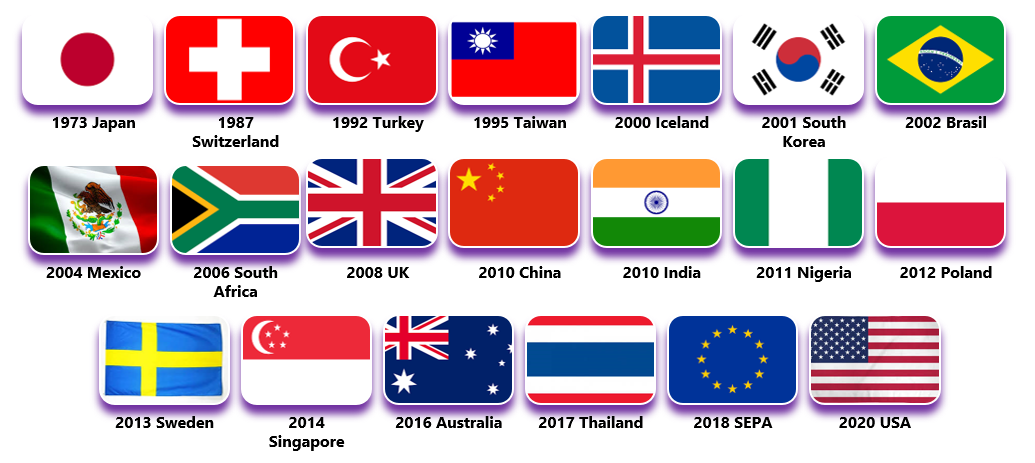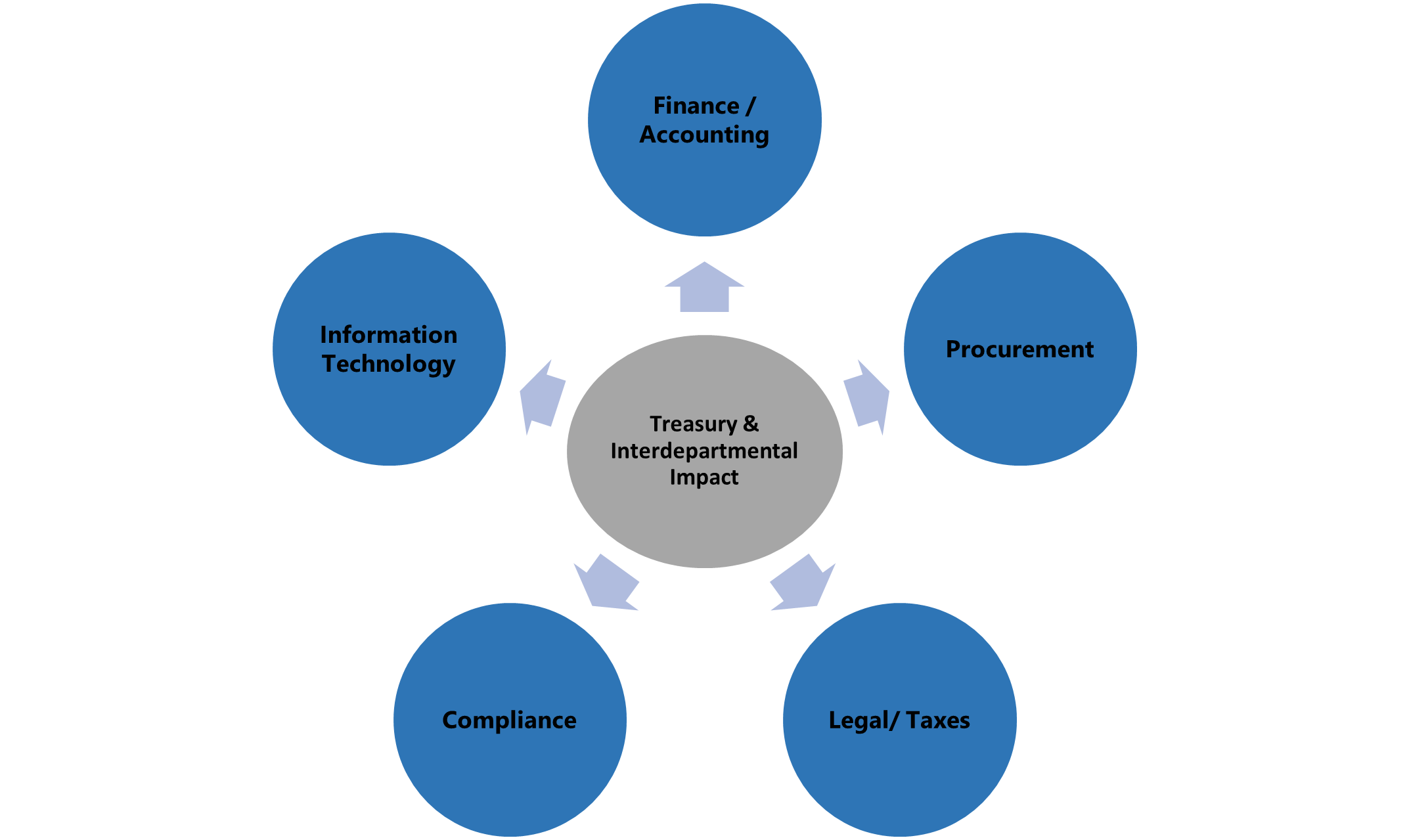Real-Time Payments (RTP) have been evolving in the pursuit of a better payment system that is safe, efficient, universal, and broadly accessible in the U.S. and abroad.
While treasurers are embracing the idea of RTP1, there are also implications for how treasury organizations transition from a typical 5-day work week to a 24/7/365 world. RTP will provide benefits such as transparency and predictability within countries and across borders, but will also impact liquidity management, foreign exchange management, and overall treasury processes & controls in a new world where treasury operations are open 24/7/365.
The continuous innovation and global momentum have brought about new platforms and solutions to create a thriving and competitive marketplace, where expectations are high, and innovation is unlocked through messaging and data standards. Technology providers are enabling and transforming the way payments are executed; customers now require immediate settlement, and many organizations are listening and adding Real-Time Payment rails as an option for their clients.
Here are some common questions organizations may come across in considering adding Real-Time Payment rails to their current infrastructure:
What Are Real-Time Payments?
A Real-Time Payment is a transaction that occurs in near-real-time, and as near to a 24-hour, seven (7) days basis as possible. The transaction must include the transmission of the payment message and the availability of final funds to the payee. Among the required elements for a transaction to be considered a Real-Time Payment, it must consist of end-to-end processing within seconds, provide good funds that are available and secure, and ensure that clearing mechanisms are in place.
How Do Real-Time Payment Rails Add Value vs. Existing Payment Rails?
The primary difference between payment rails is in the varying speeds of fund availability. Traditional payment rails generally offer next-day or two-day availability. Some organizations are still check-dependent, which translates to longer wait times for receipt of payment – in some cases, this can cause customer dissatisfaction and movement toward suppliers who do provide faster payments. Below is a recap of some of the traditional payment rails:

By enabling a Real-Time Payment rail, treasurers can provide an instant delivery option to their customers and vendors. In some cases, organizations adopting an RTP rail have gained a competitive advantage by enabling a convenient instant payment option for their customers. For example, many insurance companies are now able to settle claims instantly and provide instant funds to their variety of clients.
What are the benefits of adopting Real-Time Payments now?
In general, by using RTP organizations will be able to collect and disburse payments faster than they can with traditional payment rails. For example, organizations can collect any outstanding invoice payments faster and have immediate liquidity for strategic investment, to pay down debt, or to even have enough cash at hand for the next acquisition. RTP provides organizations with the opportunity to redefine their A/R & A/P Policies and adapt those policies to leverage instantaneous cashflows, as well as the critical timing of disbursements.
During unexpected events and emergencies, corporates, non-profits, charities, and the government face a series of complex financial decisions to make. For example, in distributing pandemic stimulus funds and income tax refunds, governments and their citizens could benefit from Real-Time Payment rails as millions of people would receive those funds instantly, mitigating the adverse effects of delays in payment. As another example, the airline and hotel industries would also benefit from RTP rails, as sending instant cancellation refunds to customers is preferable to their waiting long periods for a mailed check or alternate method of refund.
Faced with unexpected situations that require business adaptability, such as a global pandemic, a treasurer should strategically map out their existing business model, explore any opportunities for growth and increased flexibility, address any internal weaknesses that may be uncovered, and consider how their operating model would benefit from newer solutions such as an instant payment rail. Corporate treasurers are taking this opportunity to review their business models to determine how RTP may be adapted in their payment ecosystem, thus adding value to both theirs and their customer’s cash liquidity through instant availability of funds. The following are some of the benefits an RTP rail provides to organizations:

While many treasurers are embracing adding an RTP payment rail to their current treasury operations, it is important to recognize that RTP transactions are irrevocable – it is thereby important for treasurers to create a sound readiness plan that map outs the controls & segregation of duties aligned with Real-Time Payments, to ensure the validity and accuracy of payments processed through the instant rail.
Global Adoption of Real-Time Payments
Global adoption of Real-Time Payments is not a brand-new phenomenon. As illustrated in the timeline below, Real-Time Payments have been implemented worldwide for almost 50 years, and countries such as Japan, Brazil, Mexico, and the UK were among the earliest adopters. The increased momentum for this evolution in recent years comes from consumer demand and the collaboration of central banks and payment ecosystem participants like Axletree Solutions who are actively working on enabling RTP, domestic, and cross-border transactions.

Who were the catalysts of the push for Real-Time Payments adoption?
The USA Federal Reserve Faster Payments Task Force, has initiated this evolution across the industry. The task force called upon all stakeholders to seize this historic opportunity to realize the vision for a modernized payment system in the United States that is “faster, ubiquitous, broadly inclusive, safe, highly secure and efficient”2. The Federal Reserve is currently working on The FedNow Service, “a new instant payment service that the Federal Reserve Banks are developing to enable financial institutions of every size, and in every community across the U.S., to provide safe and efficient instant payment services in real time, around the clock, every day of the year.”3
What is the Role of FedNow in RTP?
In working with over a thousand members from 700 organizations in the FedNow Community, these Top 10 Takeaways & Considerations were the core of the progress FedNow made through their industry collaborations. These joint efforts brought about the standard and achieved both efficiency and effectiveness in establishing real-time instant payments. Currently the Federal Reserve is projected to launch the FedNow Service by the year 2023.
What should the Treasurer be aware of when selecting an RTP channel to add as a payment rail?
Bank connectivity is the foundation that enables RTP and understanding the impact of adding this new instant payment rail is imperative for a successful outcome. By mapping out organizations’ current payment processes and aligning the RTP rail accordingly, treasurers can gain the visibility needed to interface with primary systems such as ERP, TMS, FX trading platforms, confirmations systems, and vendors. Treasurers should make sure their technology is up to par with instant payments and consider any necessary retrofitting for their current day-to-day treasury back-office operations.
Treasurers should also ensure their organization is aligned with external vendors and banks, in addition to identifying the value of RTP, and developing the appropriate project plan and go-live timeline. Enabling an RTP rail also requires bank balances & statements to be monitored seven (7) days a week, not just Monday through Friday. Processes must be put in place to allow the back-end functionality of all systems to be retro-fitted and support the 7-days statements, and bankers & technology providers must enable the statement availability.
Treasurers should identify which of the following RTP use cases are most relevant to their organization, depending on the evolution of their business model and any changes they may need to make as a result of both expected and unexpected situations:





Are there transaction limits with instant payments?
While the current per-transaction limit is set at $25,000, FedNow recognizes that this amount is more aligned with the needs of smaller businesses and retail payments. With FedNow going live in 2023, there may be a limit increase that aligns more closely with the corporate level of high-value transactions. As RTP evolves, corporate treasurers must continue to align their sound internal controls with any transaction limit increases.
How to Secure Stakeholders’ Engagement in Moving to an RTP Rail?
Internal and external stakeholders’ engagement is crucial to successfully implementing an RTP rail. The CFO, treasurer, and all treasury personnel will be the pillars of support behind an RTP-adoption project, and they can also help share its benefits across the organization. It is important to initiate discussions with these stakeholders regarding the importance of retaining customers and providing them with value-added options in a world of evolving technology. Treasurers can encourage the adoption of RTP in their organization by emphasizing the benefits of providing instant liquidity to customers and discussing how an RTP rail would position the organization to be more competitive in an evolving marketplace.
Forecasting the cash position in a real-time world?
Enabling an RTP rail will add value to the organization, but treasurers must be ready to adjust the forecast and cash positioning model in a world where up-to-date information is expected in a matter of seconds. There needs to be a continuous adjustment in the forecast and cash position as treasury operations build the RTP transaction inflows & outflows, to adjust the variables to a new instant surplus or deficit of funds.
How would the ZBA Intra-Day Sweeps be impacted?
Many corporates have a treasury center in-house bank. Through these, corporates can leverage ZBA Intra-Day Sweeps of funds as the funds get swept from the various bank and sub-bank accounts to their in-house bank master accounts. However, the ZBA are set to sweep as an intra-day function, not a real-time one. Treasurers will need to speak with their bankers to determine if their banks have the capability of a real-time feed for the ZBA sweeps to align with the new RTP rail.
What would be the Back-Office Impact of enabling RTP for treasury?
Adopting a new payment rail will significantly change the treasury process. In an RTP treasury world, bank balance will need to be available 7-days a week – if an organization is not prepared for this, it could lead to reconciliation issues, mismatched items, and many other headaches for the treasury and accounting departments. In time-bound treasury operations, it is important to have the ability to adopt RTP to the cash position & forecast to better manage the instant liquidity or deficit enabled by the instant payment flows.
Bank & Financial Service Provider Readiness?
Treasurers should speak with all their service providers and find out if their systems are ready to support Real-Time Payments. It is important to find out whether RTP will cause any impacts to liquidity, and whether the providers have developed controls around RTP flows. If an organization’s service providers are not RTP-enabled, this could have an impact on the organization’s ability to adopt RTP. Treasurers and CFOs can help drive the universal adoption of RTP by speaking to their partners about the benefits of the transition, and encouraging them to prepare their systems to support Real-Time Payment rails.
Automation & Operational Risk?
Any time there is automation, it comes with its share of risk. To mitigate the risk when automating an RTP rail, treasurers need to have the support of key stakeholders and vendors to test before going live, and have the assurance that their technology is resilient and that the RTP rail is compliant with the organization’s IT policies.
What would be the treasury & interdepartmental impact for my organization adding RTP?
Treasury touches many important departments of an organization, and the departments must be ready to align and support the new RTP rail. Among the tasks that need to monitored and executed correctly, the Procurement department would manage vendor relationships, the Legal and Tax departments would address tax obligations and other settlements, and Treasury would provide the real-time funding to their domestic and global entities, as well as managing counterparty liquidity risk and balance sheet exposure.

But who are these payment technology networks and enablers?
The payment ecosystem & technology providers enable routing mechanisms, create and adapt their technologies to the user experience, and incorporate other services such as account validation, search directories, remittance data information, payment requests, and cross-border payments.
Payment networks are continuously evolving and providing the functionality and features that enable Real-Time Payments, including rules, payment finality, payment confirmation, settlement, fraud & risk controls, and links to other networks and directories.
For example, FedNow will be able to send an immediate, irrevocable payment within seconds, within their Real-Time gross settlement, and payment confirmation is received within seconds for the sender & receiver, along with request for payment and other non-payment messages.
Enablers such as Axletree Solutions play a significant role in making Real-Time Payments a reality, by facilitating interconnections within the payments ecosystem. Axletree is one of the founding members of the U.S. Faster Payments Council and provides RTP connectivity and enterprise integration for banks and corporates around the world.
Real-Time Payments Are Reshaping Organization and Treasury Centers
In conclusion, as Real-Time Payments evolve, treasurers will continue asking important questions as they experience the adoption of a variety of RTP use cases, and the Federal Reserve and technology providers will be the enablers of such use cases. With technology continuously advancing, treasurers are adopting Real-Time Payments in their day-to-day treasury operations, setting up an instant payment channel option that is adaptable to their business model. Many are taking the first steps in transitioning from a batch world to a real-time world based on changing customer expectations, by leveraging their vendor relationships and retrofitting their systems.
With the COVID-19 pandemic, many treasurers have seen the benefits of instant cashflows and their customers have benefited from instant funds. Treasurers continue to move away from manual transactions such as checks, for which disbursement to customers and vendors proves to be a challenge, especially during the height of a pandemic. RTP channels have increased the efficiency of organizations that have already embraced them, and have led to clients experiencing the value and connectedness of this modern payment method.
Real-Time Payments will only continue to strengthen, and now more than ever it is important for treasurers to initiate conversations with their organization’s key stakeholders, map out the process of adopting an RTP rail, and identify its short & long-term benefits for the organization.
The following are some important takeaways if your organization is considering adopting a Real-Time Payment rail:

To learn more about Real-Time Payments, send us an email at info@axletrees.com, or give us a call at +1-732-296-0001.
Want to learn more about how Real-Time Payments are changing the global landscape of payments? Read our article here: How Real-Time Payments Can Modernize the Payments Ecosystem
Written by Beatriz Saldivar
Sources:
- RTP® is a registered trademark of The Clearing House®
- “Meet the Task Force.” Federal Reserve Faster Payments Task Force. https://fasterpaymentstaskforce.org/meet-the-task-force/
- “About the FedNowSM Service.” Federal Reserve Bank Services. https://www.frbservices.org/financial-services/fednow/about.html
March 29, 2021




